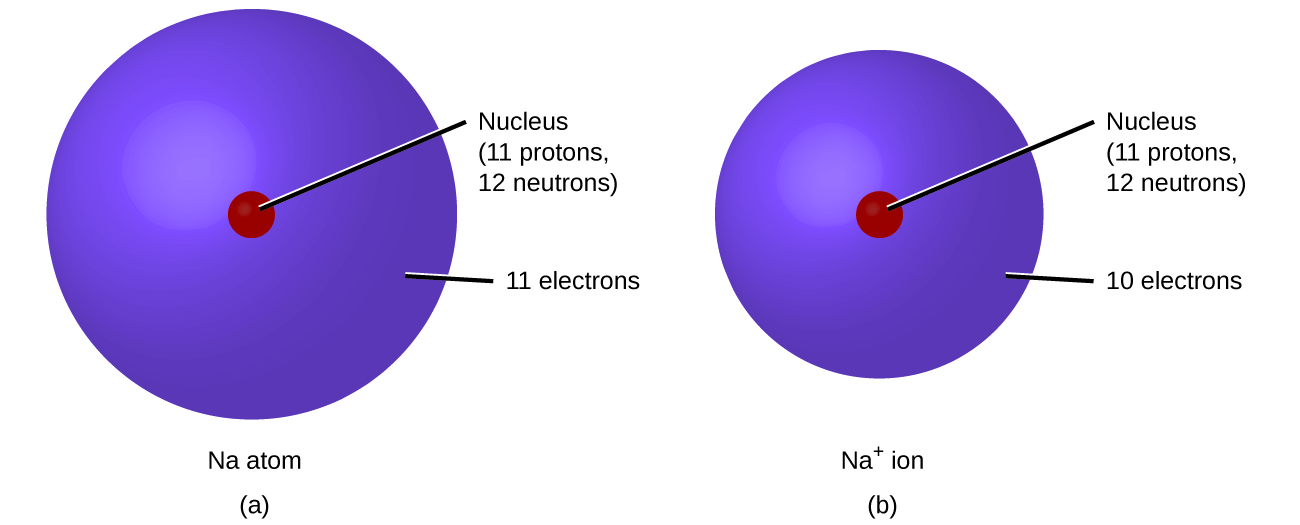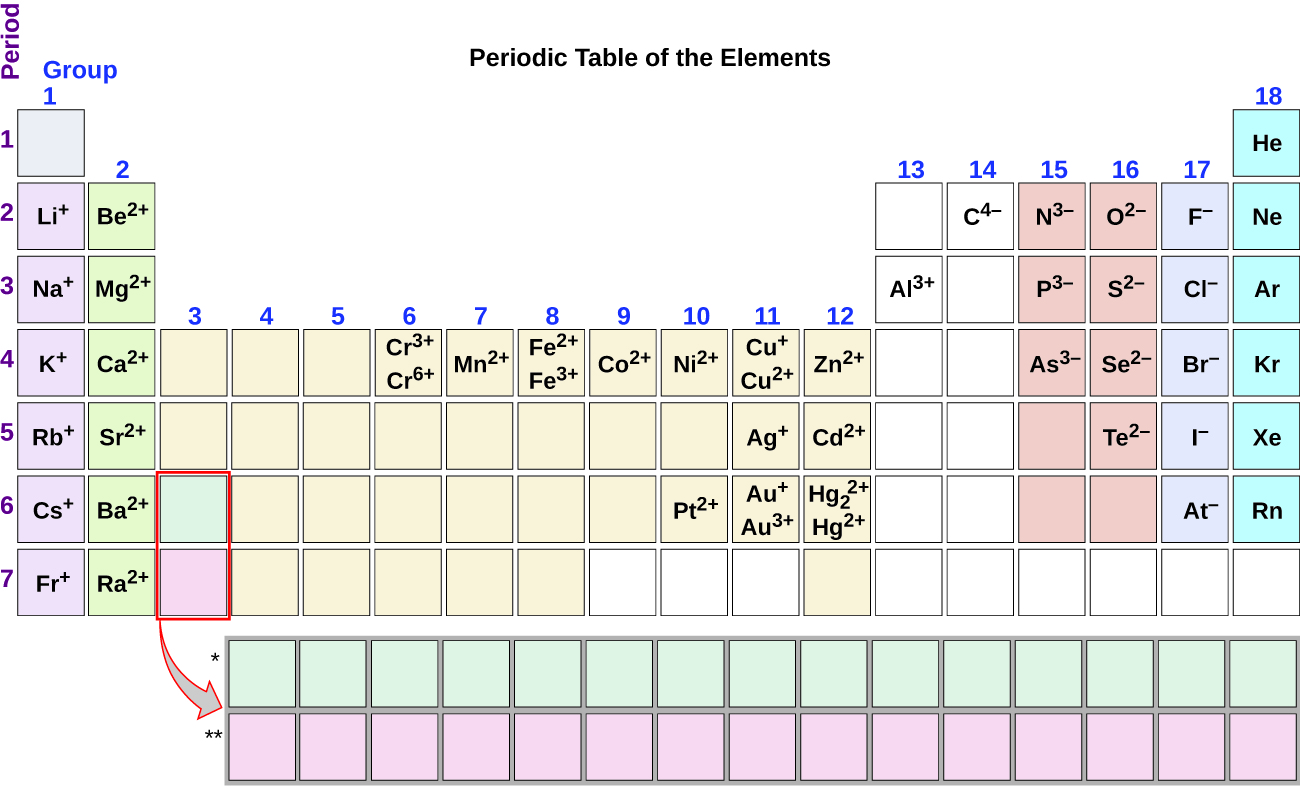How Do You Know if Something Is Molecular or Ionic
Affiliate ii. Atoms, Molecules, and Ions
2.6 Molecular and Ionic Compounds
Learning Objectives
By the stop of this department, you volition be able to:
- Define ionic and molecular (covalent) compounds
- Predict the blazon of compound formed from elements based on their location inside the periodic tabular array
- Determine formulas for uncomplicated ionic compounds
In ordinary chemic reactions, the nucleus of each atom (and thus the identity of the element) remains unchanged. Electrons, even so, tin can exist added to atoms past transfer from other atoms, lost past transfer to other atoms, or shared with other atoms. The transfer and sharing of electrons among atoms govern the chemistry of the elements. During the formation of some compounds, atoms proceeds or lose electrons, and form electrically charged particles chosen ions (Figure one).

You tin can use the periodic tabular array to predict whether an atom volition course an anion or a cation, and you tin can ofttimes predict the charge of the resulting ion. Atoms of many main-group metals lose plenty electrons to get out them with the same number of electrons every bit an cantlet of the preceding noble gas. To illustrate, an atom of an alkali metallic (group one) loses one electron and forms a cation with a 1+ charge; an alkaline earth metal (grouping 2) loses two electrons and forms a cation with a 2+ charge, and then on. For case, a neutral calcium atom, with 20 protons and twenty electrons, readily loses two electrons. This results in a cation with 20 protons, 18 electrons, and a 2+ charge. It has the same number of electrons as atoms of the preceding noble gas, argon, and is symbolized Caii+. The name of a metal ion is the same as the proper name of the metallic atom from which it forms, then Ca2+ is called a calcium ion.
When atoms of nonmetal elements class ions, they generally proceeds enough electrons to give them the same number of electrons as an atom of the next noble gas in the periodic tabular array. Atoms of group 17 gain ane electron and form anions with a i− charge; atoms of group 16 gain two electrons and form ions with a 2− accuse, and and so on. For instance, the neutral bromine cantlet, with 35 protons and 35 electrons, can gain one electron to provide it with 36 electrons. This results in an anion with 35 protons, 36 electrons, and a i− charge. It has the same number of electrons as atoms of the next noble gas, krypton, and is symbolized Br−. (A discussion of the theory supporting the favored status of element of group 0 electron numbers reflected in these predictive rules for ion formation is provided in a after chapter of this text.)
Note the usefulness of the periodic tabular array in predicting likely ion formation and charge (Figure 2). Moving from the far left to the correct on the periodic tabular array, main-group elements tend to course cations with a charge equal to the group number. That is, group 1 elements form 1+ ions; group two elements form 2+ ions, and so on. Moving from the far right to the left on the periodic tabular array, elements often form anions with a negative charge equal to the number of groups moved left from the noble gases. For example, grouping 17 elements (one group left of the noble gases) form ane− ions; group 16 elements (two groups left) grade 2− ions, and so on. This tendency can be used as a guide in many cases, but its predictive value decreases when moving toward the center of the periodic tabular array. In fact, transition metals and some other metals ofttimes exhibit variable charges that are not predictable by their location in the tabular array. For example, copper tin can grade ions with a 1+ or 2+ charge, and iron can class ions with a 2+ or 3+ charge.

Case i
Composition of Ions
An ion found in some compounds used as antiperspirants contains thirteen protons and 10 electrons. What is its symbol?
Solution
Because the number of protons remains unchanged when an atom forms an ion, the atomic number of the element must be 13. Knowing this lets us use the periodic tabular array to identify the chemical element equally Al (aluminum). The Al atom has lost 3 electrons and thus has three more than positive charges (thirteen) than it has electrons (10). This is the aluminum cation, Al3+.
Check Your Learning
Give the symbol and proper noun for the ion with 34 protons and 36 electrons.
Respond:
Setwo−, the selenide ion
Instance ii
Germination of Ions
Magnesium and nitrogen react to form an ionic compound. Predict which forms an anion, which forms a cation, and the charges of each ion. Write the symbol for each ion and name them.
Solution
Magnesium's position in the periodic table (grouping 2) tells us that it is a metal. Metals class positive ions (cations). A magnesium cantlet must lose two electrons to have the same number electrons as an atom of the previous element of group 0, neon. Thus, a magnesium cantlet volition form a cation with two fewer electrons than protons and a charge of 2+. The symbol for the ion is Mg2+, and information technology is called a magnesium ion.
Nitrogen'southward position in the periodic table (group 15) reveals that it is a nonmetal. Nonmetals form negative ions (anions). A nitrogen cantlet must gain three electrons to take the same number of electrons as an atom of the post-obit noble gas, neon. Thus, a nitrogen cantlet volition class an anion with three more electrons than protons and a charge of iii−. The symbol for the ion is N3−, and it is chosen a nitride ion.
Check Your Learning
Aluminum and carbon react to form an ionic compound. Predict which forms an anion, which forms a cation, and the charges of each ion. Write the symbol for each ion and name them.
Answer:
Al will grade a cation with a accuse of three+: Al3+, an aluminum ion. Carbon will class an anion with a charge of iv−: C4−, a carbide ion.
The ions that we have discussed so far are called monatomic ions, that is, they are ions formed from only one atom. We also find many polyatomic ions. These ions, which act as discrete units, are electrically charged molecules (a group of bonded atoms with an overall charge). Some of the more important polyatomic ions are listed in Table 6. Oxyanions are polyatomic ions that incorporate 1 or more than oxygen atoms. At this indicate in your study of chemical science, you should memorize the names, formulas, and charges of the most mutual polyatomic ions. Considering you will use them repeatedly, they will soon become familiar.
| Name | Formula | Related Acid | Formula |
|---|---|---|---|
| ammonium | [latex]\text{NH}_4^{\;\;+}[/latex] | ||
| hydronium | [latex]\text{H}_3\text{O}^{+}[/latex] | ||
| oxide | [latex]\text{O}_2^{\;\;-}[/latex] | ||
| peroxide | [latex]\text{O}_2^{\;\;two-}[/latex] | ||
| hydroxide | [latex]\text{OH}^{-}[/latex] | ||
| acetate | [latex]\text{CH}_3\text{COO}^{-}[/latex] | acetic acrid | [latex]\text{CH}_3\text{COOH}[/latex] |
| cyanide | [latex]\text{CN}^{-}[/latex] | hydrocyanic acrid | [latex]\text{HCN}[/latex] |
| azide | [latex]\text{N}_3^{\;\;-}[/latex] | hydrazoic acrid | [latex]\text{HN}_3[/latex] |
| carbonate | [latex]\text{CO}_3^{\;\;2-}[/latex] | carbonic acid | [latex]\text{H}_2\text{CO}_3[/latex] |
| bicarbonate | [latex]\text{HCO}_3^{\;\;-}[/latex] | ||
| nitrate | [latex]\text{NO}_3^{\;\;-}[/latex] | nitric acid | [latex]\text{HNO}_3[/latex] |
| nitrite | [latex]\text{NO}_2^{\;\;-}[/latex] | nitrous acid | [latex]\text{HNO}_2[/latex] |
| sulfate | [latex]\text{And so}_4^{\;\;2-}[/latex] | sulfiric acid | [latex]\text{H}_2\text{And so}_4[/latex] |
| hydrogen sulfate | [latex]\text{HSO}_4^{\;\;-}[/latex] | ||
| sulfite | [latex]\text{So}_3^{\;\;2-}[/latex] | sulfurous acid | [latex]\text{H}_2\text{SO}_3[/latex] |
| hydrogen sulfite | [latex]\text{HSO}_3^{\;\;-}[/latex] | ||
| phosphate | [latex]\text{PO}_4^{\;\;iii-}[/latex] | phosphoric acid | [latex]\text{H}_3\text{PO}_4[/latex] |
| hydrogen phosphate | [latex]\text{HPO}_4^{\;\;2-}[/latex] | ||
| dihydrogen phosphate | [latex]\text{H}_2\text{PO}_4^{\;\;-}[/latex] | ||
| perchlorate | [latex]\text{ClO}_4^{\;\;-}[/latex] | perchloric acid | [latex]\text{HClO}_4[/latex] |
| chlorate | [latex]\text{ClO}_3^{\;\;-}[/latex] | chloric acid | [latex]\text{HClO}_3[/latex] |
| chlorite | [latex]\text{ClO}_2^{\;\;-}[/latex] | chlorous acid | [latex]\text{HClO}_2[/latex] |
| hypochlorite | [latex]\text{ClO}^{-}[/latex] | hypochlorous acid | [latex]\text{HClO}[/latex] |
| chromate | [latex]\text{CrO}_4^{\;\;2-}[/latex] | chromic acid | [latex]\text{H}_2\text{Cr}_2\text{O}_4[/latex] |
| dichromate | [latex]\text{Cr}_2\text{O}_7^{\;\;two-}[/latex] | dichromic acid | [latex]\text{H}_2\text{Cr}_2\text{O}_7[/latex] |
| permanganate | [latex]\text{MnO}_4^{\;\;-}[/latex] | permanganic acid | [latex]\text{HMnO}_4[/latex] |
| Tabular array half dozen. Common Polyatomic Ions | |||
Note that there is a system for naming some polyatomic ions; -ate and -ite are suffixes designating polyatomic ions containing more or fewer oxygen atoms. Per- (short for "hyper") and hypo- (meaning "under") are prefixes pregnant more than oxygen atoms than -ate and fewer oxygen atoms than -ite, respectively. For example, perchlorate is ClOfour −, chlorate is ClOiii −, chlorite is ClO2 − and hypochlorite is ClO−. Unfortunately, the number of oxygen atoms corresponding to a given suffix or prefix is not consistent; for instance, nitrate is NO3 − while sulfate is SO4 2−. This will be covered in more item in the adjacent module on classification.
The nature of the attractive forces that hold atoms or ions together within a chemical compound is the basis for classifying chemical bonding. When electrons are transferred and ions form, ionic bonds outcome. Ionic bonds are electrostatic forces of attraction, that is, the bonny forces experienced between objects of contrary electrical charge (in this case, cations and anions). When electrons are "shared" and molecules form, covalent bonds result. Covalent bonds are the bonny forces between the positively charged nuclei of the bonded atoms and i or more pairs of electrons that are located betwixt the atoms. Compounds are classified as ionic or molecular (covalent) on the basis of the bonds present in them.
Ionic Compounds
When an element equanimous of atoms that readily lose electrons (a metal) reacts with an element composed of atoms that readily gain electrons (a nonmetal), a transfer of electrons usually occurs, producing ions. The chemical compound formed by this transfer is stabilized by the electrostatic attractions (ionic bonds) between the ions of reverse charge present in the compound. For example, when each sodium atom in a sample of sodium metal (group ane) gives up one electron to form a sodium cation, Na+, and each chlorine atom in a sample of chlorine gas (group 17) accepts i electron to form a chloride anion, Cl−, the resulting compound, NaCl, is composed of sodium ions and chloride ions in the ratio of one Na+ ion for each Cl− ion. Similarly, each calcium cantlet (group 2) can surrender ii electrons and transfer ane to each of two chlorine atoms to form CaCl2, which is composed of Ca2+ and Cl− ions in the ratio of one Ca2+ ion to 2 Cl− ions.
A compound that contains ions and is held together by ionic bonds is called an ionic compound. The periodic table can assistance us recognize many of the compounds that are ionic: When a metal is combined with one or more than nonmetals, the compound is unremarkably ionic. This guideline works well for predicting ionic compound formation for most of the compounds typically encountered in an introductory chemistry course. Nevertheless, it is not ever truthful (for example, aluminum chloride, AlClthree, is not ionic).
Yous can often recognize ionic compounds considering of their properties. Ionic compounds are solids that typically melt at high temperatures and eddy at even higher temperatures. For case, sodium chloride melts at 801 °C and boils at 1413 °C. (As a comparing, the molecular compound water melts at 0 °C and boils at 100 °C.) In solid course, an ionic compound is not electrically conductive because its ions are unable to flow ("electricity" is the flow of charged particles). When molten, however, it can deport electricity because its ions are able to move freely through the liquid (Figure 3).


Watch this video to see a mixture of salts melt and conduct electricity.
In every ionic compound, the total number of positive charges of the cations equals the total number of negative charges of the anions. Thus, ionic compounds are electrically neutral overall, fifty-fifty though they contain positive and negative ions. We can use this ascertainment to help us write the formula of an ionic compound. The formula of an ionic compound must have a ratio of ions such that the numbers of positive and negative charges are equal.
Case 3
Predicting the Formula of an Ionic Chemical compound
The gemstone sapphire (Figure 4) is mostly a compound of aluminum and oxygen that contains aluminum cations, Al3+, and oxygen anions, Oii−. What is the formula of this chemical compound?

Solution
Because the ionic compound must be electrically neutral, it must take the same number of positive and negative charges. Two aluminum ions, each with a charge of 3+, would give united states of america vi positive charges, and three oxide ions, each with a accuse of 2−, would give us 6 negative charges. The formula would be Al2O3.
Check Your Learning
Predict the formula of the ionic chemical compound formed between the sodium cation, Na+, and the sulfide anion, Sii−.
Many ionic compounds contain polyatomic ions (Tabular array 6) as the cation, the anion, or both. As with simple ionic compounds, these compounds must also be electrically neutral, then their formulas can be predicted by treating the polyatomic ions as discrete units. Nosotros use parentheses in a formula to signal a group of atoms that behave as a unit of measurement. For example, the formula for calcium phosphate, i of the minerals in our bones, is Ca3(POfour)2. This formula indicates that there are three calcium ions (Ca2+) for every two phosphate (PO4 3−) groups. The POiv 3− groups are detached units, each consisting of one phosphorus atom and four oxygen atoms, and having an overall charge of 3−. The compound is electrically neutral, and its formula shows a full count of three Ca, 2 P, and eight O atoms.
Example four
Predicting the Formula of a Compound with a Polyatomic Anion
Baking powder contains calcium dihydrogen phosphate, an ionic compound equanimous of the ions Ca2+ and H2PO4 −. What is the formula of this compound?
Solution
The positive and negative charges must balance, and this ionic compound must be electrically neutral. Thus, we must have two negative charges to balance the two+ charge of the calcium ion. This requires a ratio of one Ca2+ ion to 2 H2POfour − ions. We designate this by enclosing the formula for the dihydrogen phosphate ion in parentheses and adding a subscript 2. The formula is Ca(H2POiv)ii.
Check Your Learning
Predict the formula of the ionic chemical compound formed between the lithium ion and the peroxide ion, Otwo 2− (Hint: Utilize the periodic table to predict the sign and the charge on the lithium ion.)
Because an ionic chemical compound is not fabricated upward of single, discrete molecules, it may not be properly symbolized using a molecular formula. Instead, ionic compounds must be symbolized past a formula indicating the relative numbers of its constituent ions. For compounds containing simply monatomic ions (such as NaCl) and for many compounds containing polyatomic ions (such as CaSO4), these formulas are just the empirical formulas introduced earlier in this chapter. However, the formulas for some ionic compounds containing polyatomic ions are not empirical formulas. For example, the ionic compound sodium oxalate is comprised of Na+ and C2Ofour 2− ions combined in a two:1 ratio, and its formula is written equally Na2CtwoO4. The subscripts in this formula are not the smallest-possible whole numbers, as each can be divided by two to yield the empirical formula, NaCOtwo. This is not the accustomed formula for sodium oxalate, however, as information technology does not accurately represent the compound'due south polyatomic anion, C2O4 2−.
Molecular Compounds
Many compounds practice not contain ions only instead consist solely of discrete, neutral molecules. These molecular compounds (covalent compounds) effect when atoms share, rather than transfer (gain or lose), electrons. Covalent bonding is an important and extensive concept in chemistry, and it will exist treated in considerable detail in a subsequently chapter of this text. We can often identify molecular compounds on the basis of their physical properties. Under normal conditions, molecular compounds often exist equally gases, low-boiling liquids, and depression-melting solids, although many important exceptions exist.
Whereas ionic compounds are unremarkably formed when a metal and a nonmetal combine, covalent compounds are ordinarily formed by a combination of nonmetals. Thus, the periodic table can help us recognize many of the compounds that are covalent. While we tin use the positions of a compound'southward elements in the periodic table to predict whether it is ionic or covalent at this point in our study of chemistry, you should exist aware that this is a very simplistic arroyo that does not account for a number of interesting exceptions. Shades of grayness exist betwixt ionic and molecular compounds, and yous'll learn more than about those later.
Case 5
Predicting the Type of Bonding in Compounds
Predict whether the post-obit compounds are ionic or molecular:
(a) KI, the compound used as a source of iodine in table salt
(b) H2O2, the bleach and disinfectant hydrogen peroxide
(c) CHCliii, the anesthetic chloroform
(d) Li2CO3, a source of lithium in antidepressants
Solution
(a) Potassium (grouping 1) is a metal, and iodine (group 17) is a nonmetal; KI is predicted to exist ionic.
(b) Hydrogen (group 1) is a nonmetal, and oxygen (group 16) is a nonmetal; HtwoO2 is predicted to be molecular.
(c) Carbon (group fourteen) is a nonmetal, hydrogen (group 1) is a nonmetal, and chlorine (grouping 17) is a nonmetal; CHCl3 is predicted to be molecular.
(d) Lithium (group i) is a metallic, and carbonate is a polyatomic ion; Li2CO3 is predicted to be ionic.
Cheque Your Learning
Using the periodic table, predict whether the following compounds are ionic or covalent:
(a) SO2
(b) CaF2
(c) Due north2Hfour
(d) Al2(And so4)three
Answer:
(a) molecular; (b) ionic; (c) molecular; (d) ionic
Fundamental Concepts and Summary
Metals (especially those in groups one and 2) tend to lose the number of electrons that would leave them with the same number of electrons as in the preceding noble gas in the periodic table. By this means, a positively charged ion is formed. Similarly, nonmetals (especially those in groups 16 and 17, and, to a lesser extent, those in Group 15) tin proceeds the number of electrons needed to provide atoms with the same number of electrons as in the next noble gas in the periodic table. Thus, nonmetals tend to form negative ions. Positively charged ions are called cations, and negatively charged ions are called anions. Ions can be either monatomic (containing but one atom) or polyatomic (containing more than i cantlet).
Compounds that incorporate ions are called ionic compounds. Ionic compounds mostly form from metals and nonmetals. Compounds that exercise non contain ions, only instead consist of atoms bonded tightly together in molecules (uncharged groups of atoms that conduct as a single unit of measurement), are chosen covalent compounds. Covalent compounds usually form from ii nonmetals.
Chemical science Stop of Chapter Exercises
- Using the periodic table, predict whether the following chlorides are ionic or covalent: KCl, NCliii, ICl, MgCl2, PCl5, and CCl4.
- Using the periodic table, predict whether the following chlorides are ionic or covalent: SiCl4, PCl3, CaCl2, CsCl, CuCltwo, and CrCl3.
- For each of the post-obit compounds, country whether it is ionic or covalent. If information technology is ionic, write the symbols for the ions involved:
(a) NF3
(b) BaO,
(c) (NHiv)2CO3
(d) Sr(H2PO4)two
(due east) IBr
(f) NaiiO
- For each of the post-obit compounds, state whether it is ionic or covalent, and if it is ionic, write the symbols for the ions involved:
(a) KClO4
(b) MgC2H3O2
(c) H2S
(d) Ag2S
(due east) North2Cl4
(f) Co(NO3)2
- For each of the following pairs of ions, write the symbol for the formula of the compound they will course:
(a) Catwo+, Sii−
(b) NH4 +, So4 2−
(c) Al3+, Br−
(d) Na+, HPOfour 2−
(e) Mg2+, PO4 three−
- For each of the post-obit pairs of ions, write the symbol for the formula of the compound they will form:
(a) Yard+, Otwo−
(b) NH4+, PO4 3−
(c) Aliii+, O2−
(d) Na+, CO3 2−
(e) Ba2+, PO4 iii−
Glossary
- covalent bond
- bonny force betwixt the nuclei of a molecule'due south atoms and pairs of electrons betwixt the atoms
- covalent compound
- (besides, molecular compound) composed of molecules formed past atoms of ii or more different elements
- ionic bond
- electrostatic forces of allure betwixt the oppositely charged ions of an ionic compound
- ionic chemical compound
- compound composed of cations and anions combined in ratios, yielding an electrically neutral substance
- molecular compound
- (also, covalent compound) composed of molecules formed by atoms of ii or more different elements
- monatomic ion
- ion equanimous of a unmarried atom
- oxyanion
- polyatomic anion composed of a fundamental cantlet bonded to oxygen atoms
- polyatomic ion
- ion composed of more than than ane atom
Solutions
Answers to Chemistry End of Affiliate Exercises
ane. Ionic: KCl, MgCl2; Covalent: NClthree, ICl, PCl5, CCl4
three. (a) covalent; (b) ionic, Baii+, O2−; (c) ionic, NH4 +,CO3 ii−; (d) ionic, Sr2+, H2POfour −; (e) covalent; (f) ionic, Na+, O2−
five. (a) CaS; (b) (NH4)2SOfour; (c) AlBr3; (d) Na2HPO4; (e) Mg3 (PO4)2
Source: https://opentextbc.ca/chemistry/chapter/2-6-molecular-and-ionic-compounds/
0 Response to "How Do You Know if Something Is Molecular or Ionic"
Post a Comment